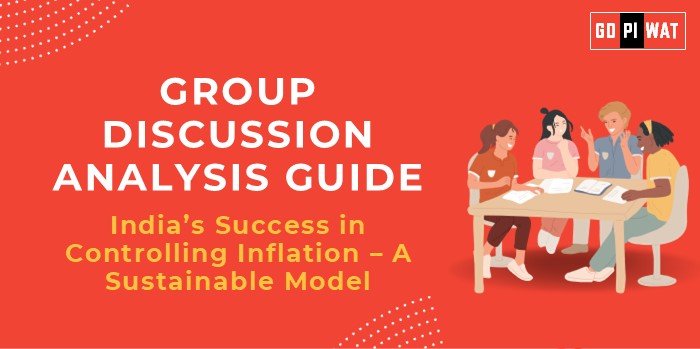📋 Group Discussion Analysis Guide
🌐 Topic: India’s Success in Controlling Inflation – A Sustainable Model?
📖 Introduction to the Topic
Opening Context: Inflation control is a critical barometer of economic health, especially for a fast-growing economy like India. Despite recent successes in stabilizing inflation, a spike in consumer prices in late 2024 raises questions about the sustainability of current measures.
Topic Background: India has historically grappled with inflation due to its dependence on agricultural outcomes, energy imports, and dynamic fiscal policies. While India’s Reserve Bank has pursued a steady monetary stance, external and structural factors have posed recurring challenges.
📊 Quick Facts and Key Statistics
- India’s CPI Inflation: Increased from 5.49% (September 2024) to 6.21% (October 2024), surpassing the RBI’s comfort zone.
- Global Comparison: India’s inflation rate remains slightly lower than the global average of 6.3% (World Bank, 2024).
- Food Inflation: Food prices rose by 10.87% year-on-year in October 2024, marking the highest increase since July 2023.
- Interest Rates: The RBI maintained the repo rate at 6.50% throughout 2023-24.
👥 Stakeholders and Their Roles
- Government of India: Implements fiscal policies, subsidies, and trade interventions to control price volatility.
- Reserve Bank of India (RBI): Balances inflation control with economic growth using monetary tools like repo rate adjustments.
- Private Sector: Optimizes supply chain operations and pricing strategies in response to inflation trends.
- Citizens: Directly impacted by price changes, particularly in food and essential commodities.
- Global Institutions: Provide frameworks for policy comparison and best practices, influencing national strategies.
🏆 Achievements and Challenges
Achievements:
- Stable Policy Rates: The RBI’s consistent repo rate has supported economic growth amidst inflationary pressures.
- Global Standing: Despite recent spikes, India’s inflation rate remains below the global average, reflecting relative stability.
- Reduced Energy Volatility: Subsidies and diversified energy imports have buffered energy-related price shocks.
Challenges:
- Rising Food Inflation: Food prices surged by 10.87% year-on-year in October 2024.
- Agricultural Productivity Gaps: Low productivity has failed to offset supply-side pressures.
- Global Economic Volatility: External shocks, including oil price fluctuations, contribute to domestic inflationary trends.
🌍 Global Comparisons
- US Federal Reserve: Aggressive rate hikes have curbed inflation to ~3.7% but impacted growth.
- EU: Prolonged inflationary trends due to energy dependency highlight structural vulnerabilities.
Case Study: Madhya Pradesh’s Agricultural Strategy: Effective irrigation and post-harvest management stabilized local food prices, but scalability remains a challenge.
🔍 Structured Arguments for Discussion
- Supporting Stance: “India’s inflation control measures, such as maintaining steady interest rates and minimizing external price shocks, demonstrate effective policy intervention despite global challenges.”
- Opposing Stance: “Recent inflationary spikes, particularly in food prices, highlight systemic gaps in agricultural productivity and price stabilization mechanisms.”
- Balanced Perspective: “While India’s inflation management strategies have shown relative success globally, underlying vulnerabilities like food inflation and rural supply chain inefficiencies need immediate attention.”
🗨️ Effective Discussion Approaches
- Opening Approaches:
- “India’s October 2024 inflation rate of 6.21% reflects a renewed challenge in managing food and consumer prices effectively.”
- “India’s inflation rate remains lower than the global average, underscoring a relatively stable policy framework.”
- Counter-Argument Handling:
- Highlight structural reforms needed in agriculture and supply chains.
- Use global examples, such as the US and EU’s monetary responses, to provide context.
📋 Strategic Analysis of Strengths and Weaknesses
- Strengths:
- Steady monetary policy from the RBI.
- Resilience against external energy price shocks.
- Weaknesses:
- Escalating food inflation.
- Agricultural dependence on monsoon variability.
- Opportunities:
- Increase investment in climate-resilient agriculture.
- Build robust rural supply chains.
- Threats:
- External economic shocks.
- Escalating rural-urban disparities in price stability.
🌟 Connecting with B-School Applications
- Real-World Applications: Analyze inflation trends for use in financial forecasting models, corporate pricing strategies, and policymaking.
- Sample Interview Questions:
- “What factors differentiate India’s inflation management from global counterparts?”
- “How can sustainable agriculture contribute to inflation control?”
- Insights for B-School Students:
- Explore inflation’s impact on consumer behavior and business profitability.
- Examine policy trade-offs between inflation control and economic growth.


